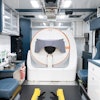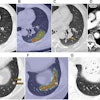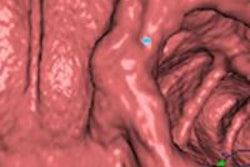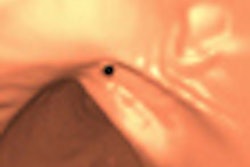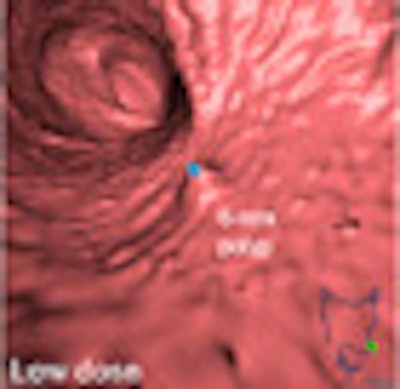
Boston researchers have come up with a tool to reduce image noise in ultralow-dose virtual colonoscopy, paving the way toward computer-aided detection (CAD) that is compatible with today's ultralow-dose scanning techniques.
In a presentation at the recent Computer Assisted Radiology and Surgery (CARS) meeting in Berlin, the study team showed how its surface-preserving denoising algorithm, which smoothes out image noise without erasing polyps from CT data, didn't change detection rates for the large polyps that were expected to be found even at low-dose scanning. But the method boosted CAD detection of 6- to 9-mm lesions to levels approaching standard-dose virtual colonoscopy (also known as CT colonography or CTC).
CTC is effective and ready to use in large-scale population screening, said Janne Näppi, PhD, from Massachusetts General Hospital.
"But now there are concerns about ionizing radiation, and the possibility of repeat scans and follow-up exams and perhaps other exams," he said. "Of course, the dose risk is largely theoretical and there are many unanswered questions about the risk of doses smaller than 100 mSv."
Doses are certainly well under that level for virtual colonoscopy exams, which are typically acquired using 5 to 10 mSv of radiation at standard-dose scans -- and 1 to 2 mSv at ultralow-dose scans, depending on the estimate method and the patient, Näppi said.
Näppi, along with Hiroyuki Yoshida, PhD, and colleagues from Kumamoto University in Japan, aimed to learn what would happen if their CAD system were trained on standard-dose cases but run on ultralow-dose CT data, as occurs in clinical practice.
"That's what happens if you deploy CAD in a hospital -- you have to use the system as is," Näppi said.
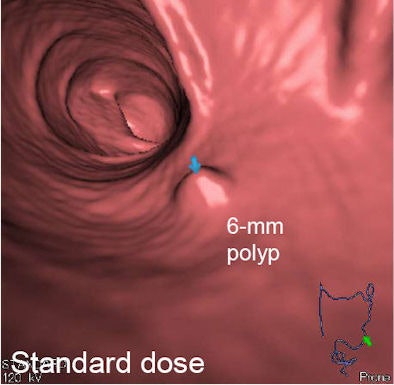 |
| Image below shows the noise effect of ultralow-dose imaging on 3D reconstructions of CTC data versus standard-dose acquisition above. All images courtesy of Janne Näppi, Ph.D. |
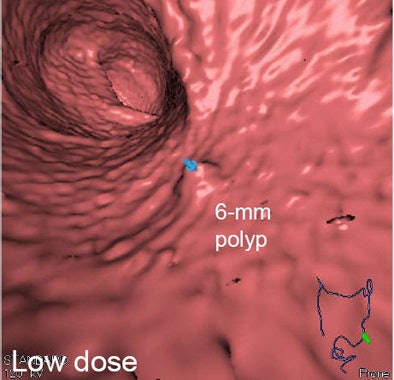 |
The researchers trained the CAD algorithm on 43 (24 abnormal) cases from two institutions at standard dose. They then tested it on a separate set of 24 CTC cases acquired using standard-dose supine and prone images (100 mAs, 120 kVp), as well as 24 supine studies acquired at 20 mAs and 120 kVp -- all acquired at 2.5-mm section thickness.
Finally, the ultralow-dose images were run through two filtering methods. Studies have demonstrated that CAD performance in CTC can be improved with the use of Gaussian smoothing, so the group added a third set of 24 ultralow-dose CTC cases preprocessed, alternately, with a Gaussian smoothing technique and the group's newly developed surface-preserving denoising technique.
Gaussian denoising uses a symmetric kernel that may blur important image details, Näppi said. But surface-preserving denoising, which controls the Gaussian smoothing process based on distance and by intensity contrast, can avoid the blurring of important surface details.
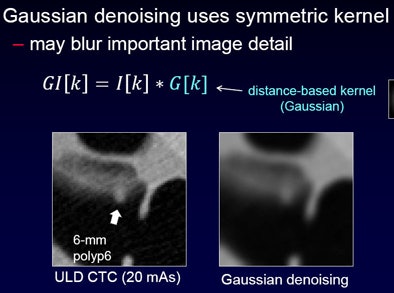 |
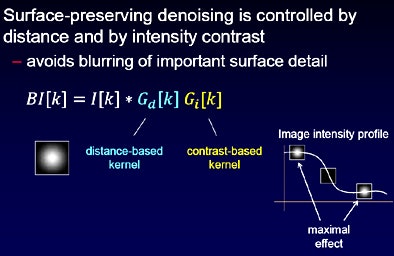 |
The three types of acquisitions -- standard dose, ultralow-dose, and ultralow-dose with Gaussian smoothing -- were examined with CAD and compared.
The group's previously described CAD system detects polyps by means of shape-based features, then reduces false positives using a Bayesian neural network based on the shape and texture of the detected regions, Näppi said.
The training dataset contained a total of 44 lesions 6 mm or larger, including 26 polyps 10 mm and larger and 18 polyps 6 to 9 mm in diameter.
The testing dataset had a total of 19 colonoscopy-confirmed lesions larger than 6 mm, (9 > 10 mm, 10 = 6-9 mm) including four masses, two pedunculated polyps, nine sessile polyps, and four flat lesions.
Näppi and colleagues found the following regarding sensitivity:
- Using standard-dose (SD) CTC, the detection sensitivity of the pretrained CAD system was 100% for lesions 10 mm and larger and 90% for lesions 6 to 9 mm, with a median of nine false-positive detections per patient.
- Using ultralow-dose (ULD) CTC, detection sensitivity dropped to 78% for lesions 10 mm and larger and 70% for lesions 6 to 9 mm, with a median of four false-positive detections per patient.
- With Gaussian denoising (GD), CAD sensitivity for large lesions remained at 100%; however, detection in the critical 6- to 9-mm size range dropped to 60%, even lower than with unaided ultralow-dose CTC. The overall sensitivity for polyps 6 mm and larger was 74%.
- Using surface-preserving denoising (SPD), detection sensitivity was 100% for large lesions, 70% for 6- to 9-mm lesions, and 84% overall for polyps 6 mm and larger.
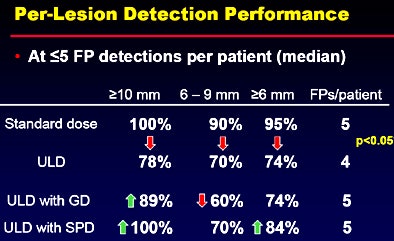 |
Surface-preserving denoising improves delineation of small polyps by turning the Gaussian denoising on and off near surfaces, Näppi explained.
"For homogeneous regions we perform this smoothing with Gaussian," Näppi said. "But in cases where we have high-contrast differences such as near surfaces, there is less smoothing with surface-preserving denoising. Surface-preserving denoising keeps these images more like the original, but also reduces noise in the homogeneous regions and preserves surfaces."
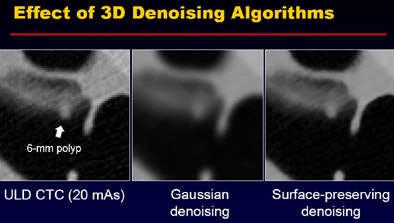 |
| By retaining the surface contours of smaller lesions, surface-preserving denoising retains detectability of some subtle lesions by CAD. |
Conventional CAD optimized for standard-dose CTC cases can have 20% lower detection sensitivity in ultralow-dose CTC cases, Näppi said.
Difficult-to-detect 6- to 9-mm polyps and morphologically flat lesions are especially hard to find in ultralow-dose virtual colonoscopy CAD -- though ultralow-dose scanning has only a marginal effect on CAD sensitivity for easy-to-detect polyps.
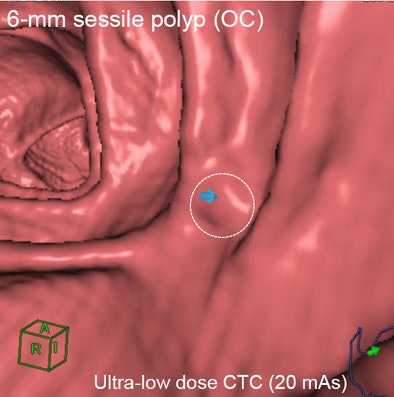 |
| Image shows 6-mm sessile polyp missed by the ultralow-dose plus Gaussian smoothing technique. It was detected with use of the surface-preserving algorithm. |
Gaussian denoising of ultralow-dose CTC data improves CAD sensitivity; however, it may reduce sensitivity for subtle 6- to 9-mm polyps.
"For flat lesions and subtle polyps, you have to be careful about smoothing ultralow-dose images," he said. "But if we do surface-preserving denoising, detection sensitivity goes up even higher [than with Gaussian filtering] -- actually comparable to standard-dose scans. Surface-preserving denoising is a promising method; maybe with some optimization, we could do better scans with this method."



